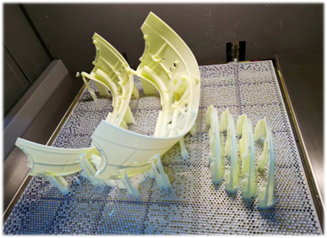ABOUT US
Fengyuan: A Leading Innovator in Advanced Manufacturing Solutions
Fengyuan stands at the forefront of technological innovation, specializing in the research, development, and production of cutting-edge 3D printing machines, alongside precision manufacturing services including small-batch plastic silicone vacuum molding, injection molding, CNC prototyping, rapid metal casting, stamping, alloy die-casting, and custom tooling solutions.
Located in the Hydrogen Energy Industrial Zone of Nantong City, Jiangsu Province, our 6,000-square-meter state-of-the-art facility houses over 40 advanced domestic and international machines, operated by a team of over 60 highly skilled senior technicians. Renowned for our expertise in composite material processing, we excel in delivering rapid prototyping (RP) components across plastics, sheet metal, and integrated assemblies, ensuring seamless integration of design, engineering, and production.
With a relentless focus on quality and efficiency, Fengyuan combines cutting-edge technology with decades of industry experience to provide tailored manufacturing solutions that meet the evolving demands of global markets.
WHAT WE DO AND WHAT WE HAVE
RP parts design and production
Reverse printing service
3d printer production
3d printer production
"3D printing, or additive manufacturing (AM), integrates computer-aided design (CAD), material engineering, and advanced fabrication technologies to translate digital models into physical components.
Leveraging software-driven CNC systems, this process deposits specialized materials—such as polymers, metals, and composites—in precise layers via methods including fused deposition modeling (FDM), selective laser sintering (SLS), laser melting (SLM), stereolithography (SLA), or binder jetting."
A photocurable resin material for industrial applications that can be reused in bending, compression and other application scenarios.
It can restore its original shape after compression or bending.
It also has excellent tear resistance and is transparent in color.
It can be used in elastic parts such as mobile phone cases, instruments, toys, shoe molds, etc.
New material R&D





Rapid prototypes production
Stereolithography (SLA) is the oldest and most advanced 3D printing technology.Its core principle involves layer-by-layer additive manufacturing: a 3Dmodel is sliced into thin horizontal layers, and an ultraviolet (UV) light beam selectively cures liquid photopolymer resin.
Irradiated areas of each layer solidify into precise cross-sections, while unexposed regions remain fluid. Successive layers are bonded together to form the final object, achieving nearly 100% material efficiency.
Our team is able to respond quickly to customer needs and provide efficient services.
Reverse 3d printing service
The traditional product design process follows a 'forward design' workflow:designers first conceptualize a product’s aesthetics, functionality, and preliminary technical specifications, then use CAD software to create a 3D digital model. This model is transmitted to manufacturing to
finalize the product’s design-to-manufacturing cycle.
In contrast, reverse engineering operates in reverse, starting from an existing physical object to derive its design data—including technical drawings or digital models. It leverages advanced digital technologies and geometric modeling techniques to transform physical prototypes into
editable CAD formats.




















